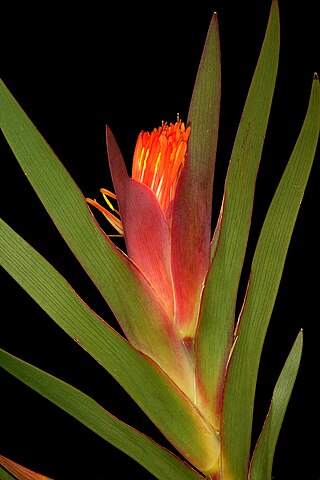
Sisyrinchium is a large genus of annual to perennial flowering plants in the family Iridaceae. Native to the New World, the species are known as blue-eyed grasses. Although they are not true grasses (Poaceae), they are monocots.

Geosiris is a genus in the flowering plant family Iridaceae, first described in 1894. It was thought for many years to contain only one species, Geosiris aphylla, endemic to Madagascar. But then in 2010, a second species was described, Geosiris albiflora, from Mayotte Island in the Indian Ocean northwest of Madagascar. In 2017, a third species was found in Queensland, Australia, Geosiris australiensis.

Tigridieae is a tribe of plants in the subfamily Iridoideae and included in the family Iridaceae. It contains many perennials which have cormous rootstocks. The name of the tribe comes from its main genus - Tigridia. The tribe is native to the New World.

Crocus flavus, known as yellow crocus, Dutch yellow crocus or snow crocus, is a species of flowering plant in the genus Crocus of the family Iridaceae. It grows wild on the slopes of Greece, former Yugoslavia, Bulgaria, Romania and northwestern Turkey, with fragrant bright orange-yellow flowers. It is a small crocus (5–6 cm, despite the names of some cultivars, compared to the giant Dutch crocuses. Its cultivars are used as ornamental plants.

Alophia is a small genus of perennial, herbaceous and bulbous plants in the family Iridaceae. The genus comprise five known species that occur from the South-central United States as well as in Mexico, Central America, and parts of South America.

Bobartia is a genus of evergreen, perennial and bulbous plants in the iris family (Iridaceae). The genus comprises 15 species distributed in South Africa. The genus name is a tribute to German botanist Jakob Bobart.

Calydorea is a small genus of perennial, herbaceous and bulbous plants in the family Iridaceae native to Mexico and South America. The plants in the genus are small with tunicated bulbs. The flowers are light blue, violet, white, or yellow, depending on the species, of which there are around twenty. Taxonomists considered that the already known genera Salpingostylis, Cardiostigma, Catila and Itysa are not enough different from each other to justify their taxonomic segregation and, for this reason, all of them are now included in Calydorea.

Devia is a genus of plants in the family Iridaceae first described in 1990. It contains only one known species, Devia xeromorpha, endemic to the southwestern part of Cape Province in South Africa. The genus was named in honour of the South African botanist and academic, Miriam Phoebe de Vos.

Isophysis is a genus of herbaceous, perennial and rhizomatous plants in the Iris family (Iridaceae). A monotypic genus formerly known as Hewardia, it contains a single species, Isophysis tasmanica is a Palaeoendemic found only in the south-west of Tasmania.
Zygotritonia is a genus of herbaceous, perennial and bulbous plants in the family Iridaceae. It contains four species distributed throughout sub-Saharan Africa. The genus name is derived from the word zygomorphic, and the apparent resemblance to some species in the genus Tritonia.
Xenoscapa is a genus of herbaceous, perennial and bulbous plants in the family Iridaceae. It consists of only three species distributed in Africa, and is closely related to the genera Freesia. The genus name is derived from the Greek words xenos, meaning "strange", and scapa, meaning "flowering stem".

Solenomelus is a genus of South American species of flowering plants in the family Iridaceae. They are very closely allied to Sisyrinchium with rhizomes, flowers with a perianth tube and a style that is not divided and a single capitate stigma. The genus name is derived from the Greek words solen, meaning "tube", and melos, meaning "member".

Klattia is a genus of flowering plants in the family Iridaceae first described as a genus in 1877. The entire genus is endemic to Cape Province in South Africa. The genus name is a tribute to the German botanist Friedrich Wilhelm Klatt, who significantly advanced the body of knowledge of the family Iridaceae in the 19th century.

Mastigostyla is a genus of flowering plants in the family Iridaceae, first described as a genus in 1928. The entire group is endemic to South America. The genus name is derived from the Greek words mastigos, meaning "whip", and stylos, meaning "style".

Melasphaerula is a genus of flowering plants in the family Iridaceae, first described as a genus in 1803. There is only one known species, Melasphaerula graminea, native to Namibia and the Cape Province in South Africa.

Micranthus is a genus of flowering plants in the family Iridaceae. The entire genus is endemic to Cape Province in South Africa.

Pillansia is a genus of flowering plants in the family Iridaceae, first described as a genus in 1914. It contains only one known species, Pillansia templemannii, endemic to Cape Province in South Africa.

Trimezia is a genus of flowering plants in the family Iridaceae, native to the warmer parts of southern Mexico, Central America, South America, Florida, and the West Indies. Trimezia is placed in the tribe Trimezieae. The division of the tribe into genera has varied considerably. In one approach, it contains only the genus Trimezia, which then includes the genera Neomarica, Pseudotrimezia and Pseudiris. In other approaches, two to five genera are recognized, sometimes also including the genus Deluciris.

Iris tuberosa is a species of tuberous flowering plant of the genus Iris, with the common names snake's-head, snake's-head iris, widow iris, black iris, or velvet flower-de-luce.
Phalocallis is a genus of plants in the Iridaceae, first described as a genus in 1839. It contains only one recognized species, Phalocallis coelestis, native to Paraná State in southern Brazil, and also in northeastern Argentina.
















